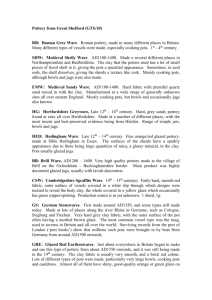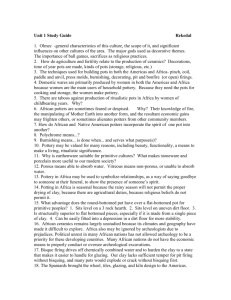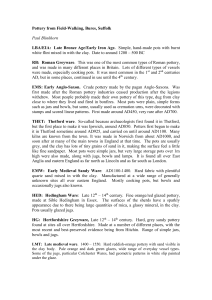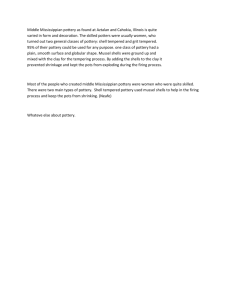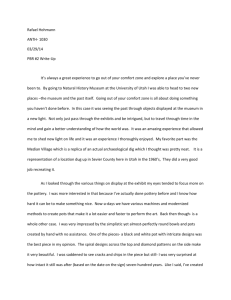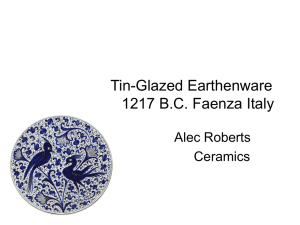Pottery from Pirton Community Test
advertisement
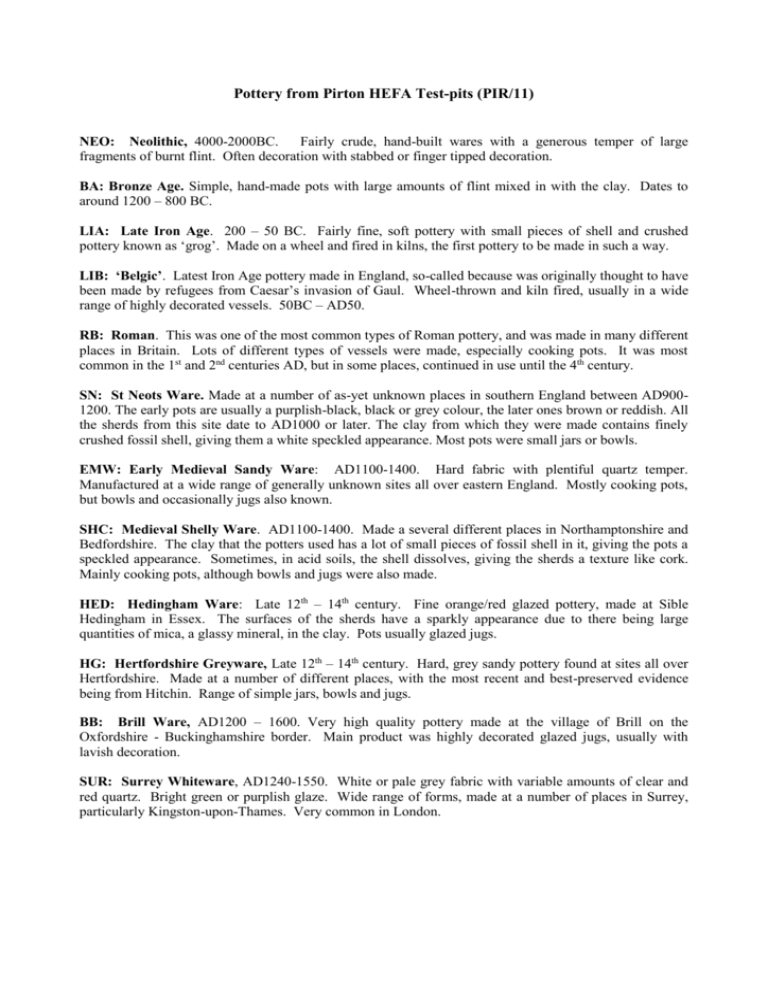
Pottery from Pirton HEFA Test-pits (PIR/11) NEO: Neolithic, 4000-2000BC. Fairly crude, hand-built wares with a generous temper of large fragments of burnt flint. Often decoration with stabbed or finger tipped decoration. BA: Bronze Age. Simple, hand-made pots with large amounts of flint mixed in with the clay. Dates to around 1200 – 800 BC. LIA: Late Iron Age. 200 – 50 BC. Fairly fine, soft pottery with small pieces of shell and crushed pottery known as ‘grog’. Made on a wheel and fired in kilns, the first pottery to be made in such a way. LIB: ‘Belgic’. Latest Iron Age pottery made in England, so-called because was originally thought to have been made by refugees from Caesar’s invasion of Gaul. Wheel-thrown and kiln fired, usually in a wide range of highly decorated vessels. 50BC – AD50. RB: Roman. This was one of the most common types of Roman pottery, and was made in many different places in Britain. Lots of different types of vessels were made, especially cooking pots. It was most common in the 1st and 2nd centuries AD, but in some places, continued in use until the 4th century. SN: St Neots Ware. Made at a number of as-yet unknown places in southern England between AD9001200. The early pots are usually a purplish-black, black or grey colour, the later ones brown or reddish. All the sherds from this site date to AD1000 or later. The clay from which they were made contains finely crushed fossil shell, giving them a white speckled appearance. Most pots were small jars or bowls. EMW: Early Medieval Sandy Ware: AD1100-1400. Hard fabric with plentiful quartz temper. Manufactured at a wide range of generally unknown sites all over eastern England. Mostly cooking pots, but bowls and occasionally jugs also known. SHC: Medieval Shelly Ware. AD1100-1400. Made a several different places in Northamptonshire and Bedfordshire. The clay that the potters used has a lot of small pieces of fossil shell in it, giving the pots a speckled appearance. Sometimes, in acid soils, the shell dissolves, giving the sherds a texture like cork. Mainly cooking pots, although bowls and jugs were also made. HED: Hedingham Ware: Late 12th – 14th century. Fine orange/red glazed pottery, made at Sible Hedingham in Essex. The surfaces of the sherds have a sparkly appearance due to there being large quantities of mica, a glassy mineral, in the clay. Pots usually glazed jugs. HG: Hertfordshire Greyware, Late 12th – 14th century. Hard, grey sandy pottery found at sites all over Hertfordshire. Made at a number of different places, with the most recent and best-preserved evidence being from Hitchin. Range of simple jars, bowls and jugs. BB: Brill Ware, AD1200 – 1600. Very high quality pottery made at the village of Brill on the Oxfordshire - Buckinghamshire border. Main product was highly decorated glazed jugs, usually with lavish decoration. SUR: Surrey Whiteware, AD1240-1550. White or pale grey fabric with variable amounts of clear and red quartz. Bright green or purplish glaze. Wide range of forms, made at a number of places in Surrey, particularly Kingston-upon-Thames. Very common in London. HGW: Hertfordshire Glazed Ware. Mid 14th – 15th century. usually highly decorated. Glazed jugs from an unknown source, LMT: Late medieval ware. 1400 – 1550. Hard reddish-orange pottery with sand visible in the clay body. Pale orange and dark green glazes, wide range of everyday vessel types. GS: German Stonewares. First made around AD1350, and some types still made today. Made at lots of places along the river Rhine in Germany, such as Cologne, Siegburg and Frechen. Very hard grey clay fabric, with the outer surface of the pot often having a mottled brown glaze, with some having blue and purple painted decoration, and others moulded medallions (‘prunts’) with coat-of-arms or mythical scenes on them. The most common vessel type was the mug, used in taverns in Britain and all over the world. Surviving records from the port of London (‘port books’) show that millions such pots were brought in by boat from Germany from around AD1500 onwards. GRE: Glazed Red Earthenwares: Just about everywhere in Britain began to make and use this type of pottery from about AD1550 onwards, and it was still being made in the 19 th century. The clay fabric is usually very smooth, and a brick red colour. Lots of different types of pots were made, particularly very large bowls, cooking pots and cauldrons. Almost all of them have shiny, good-quality orange or green glaze on the inner surface, and sometimes on the outside as well. From about AD1680, black glaze was also used. DW: Delft ware. The first white-glazed pottery to be made in Britain. Called Delft ware because of the fame of the potteries at Delft in Holland, which were amongst the first to make it. Soft, cream coloured fabric with a thick white glaze, often with painted designs in blue, purple and yellow. First made in Britain in Norwich around AD1600, and continued in use until the 19th century. The 17th century pots were expensive table wares such as dishes or bowls, but by the 19th century, better types of pottery was being made, and it was considered very cheap and the main types of pot were such as chamber pots and ointment jars. HSW: Harlow Slipware. Similar to glazed red earthenware (GRE), but with painted designs in yellow liquid clay (‘slip’) under the glaze. Made at many places between 1600 and 1700, but the most famous and earliest factory was at Harlow in Essex. SS: Staffordshire Slipware. Made between about AD1640 and 1750. This was the first pottery to be made in moulds in Britain since Roman times. The clay fabric is usually a pale buff colour, and the main product was flat dishes and plates, but cups were also made. These are usually decorated with thin brown stripes and a yellow glaze, or yellow stripes and a brown glaze. SMW: Staffordshire Manganese Ware, late 17th – 18th century. Made from a fine, buff-coloured clay, with the pots usually covered with a mottled purple and brown glaze. A wide range of different types of pots were made, but mugs and chamber pots are particularly common. EST: English Stoneware: Very hard, grey fabric with white and/or brown surfaces. First made in Britain at the end of the 17th century, became very common in the 18th and 19th century, particularly for mineral water or ink bottles and beer jars. VIC: ‘Victorian’. A wide range of different types of pottery, particularly the cups, plates and bowls with blue decoration which are still used today. First made around AD1800. RESULTS Test Pit 8 TP 8 8 8 8 8 8 Context 1 2 3 4 5 6 BA No Wt 1 HGW No Wt 3 1 1 1 1 LMT No Wt GRE No Wt VIC No Wt 2 3 4 9 3 2 1 1 3 2 Date Range 1800-1900 1800-1900 2000BC - 1550 1350-1600 1350-1450 2000-800BC The range of pottery types from this test-pit shows that people were using the site in the late medieval and early post-medieval periods, from approximately 1350 – 1600. It then appears to have been abandoned until the Victorian era. The are also two pieces of prehistoric pottery, indicating that there were people using the site in the Bronze Age, between 3, 000 and 4000 years ago. Test Pit 9 TP 9 9 9 9 9 9 Context 1 2 3 4 5 7 SN No Wt SHC No Wt 1 1 EMW No Wt HG No Wt 1 5 1 7 2 2 1 3 GRE No Wt 1 7 2 6 SMW No Wt 1 9 VIC No Wt 2 7 5 21 7 68 9 44 2 4 Date Range 1800-1900 1550-1900 1150-1900 1100-1900 1000-1900 1100-1150 This test-pit shows that the site was occupied by people from the late Saxon period, around AD1000, until the late 12th or 13th century. It then appears to have been abandoned until the late 16th or 17th century, and has been used ever since. Test Pit 10 TP 10 10 10 10 Context 1 2 3 4 SN No Wt 1 3 4 17 SHC No Wt 2 1 4 1 EMW No Wt 2 1 9 2 HG No Wt 1 1 2 3 6 5 BB No Wt HGW No Wt 1 1 1 LMT No Wt 2 4 GRE No Wt 3 1 46 4 HSW No Wt 1 9 VIC No Wt 6 26 3 6 2 3 4 The pottery from this test-pit shows that the site has had a long period of occupation, with people first using it in the late Saxon period, from around AD900, until the 17th century. It there appears to have fallen from use until Victorian times. Test Pit 11 TP 11 11 11 11 11 Context 1 2 3 4 5 EMW No Wt 1 2 HG No Wt 1 4 1 6 GRE No Wt 3 113 1 90 1 4 ES No Wt 1 6 VIC No Wt 1 1 76 166 19 83 6 18 1 1 Date Range 1550-1900 1550-1900 1150-1900 1800-1900 1100-1900 The pottery from this test-pit shows that people were using the site in the 12th and 13th centuries, but the small amount of pottery suggests that it was fields rather than where they were living. This pattern of use seems to have carried on in the post-medieval period, until Victorian times, at which point people began to live there. Date Range 1800-1900 1150-1900 1000-1900 900-1350 Test Pit 12 TP 12 12 12 12 12 12 Context 1 2 3 4 5 8 RB No Wt EMW No Wt HG No Wt HGW No Wt 1 1 37 1 1 1 4 3 5 1 2 3 4 GRE No Wt VIC No Wt 2 4 4 1 1 11 6 1 1 1 1 2 4 Date Range 1800-1900 1350-1450 1100-1600 1100-1900 100-1900 1800-1900 The pottery from this site shows that people were using the site throughout the medieval period, and that it was probably abandoned around AD1600, until Victorian times. There is also a single large piece of Roman pottery, showing that is was also in use then, but was abandoned around AD400 until after the Norman Conquest


